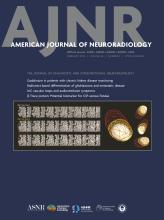This article requires a subscription to view the full text. If you have a subscription you may use the login form below to view the article. Access to this article can also be purchased.
Graphical Abstract
Abstract
BACKGROUND AND PURPOSE: Normalized relative cerebral blood volume (nrCBV) and percentage of signal recovery (PSR) computed from dynamic susceptibility contrast (DSC) perfusion imaging are useful biomarkers for differential diagnosis and treatment response assessment in brain tumors. However, their measurements are dependent on DSC acquisition factors, and CBV-optimized protocols technically differ from PSR-optimized protocols. This study aimed to generate “synthetic” DSC data with adjustable synthetic acquisition parameters using dual-echo gradient-echo (GE) DSC datasets extracted from dynamic spin-and-gradient-echo echoplanar imaging (dynamic SAGE-EPI). Synthetic DSC was aimed at: 1) simultaneously create nrCBV and PSR maps using optimal sequence parameters, 2) compare DSC datasets with heterogeneous external cohorts, and 3) assess the impact of acquisition factors on DSC metrics.
MATERIALS AND METHODS: Thirty-eight patients with contrast-enhancing brain tumors were prospectively imaged with dynamic SAGE-EPI during a non-preloaded single-dose contrast injection and included in this cross-sectional study. Multiple synthetic DSC curves with desired pulse sequence parameters were generated using the Bloch equations applied to the dual-echo GE data extracted from dynamic SAGE-EPI datasets, with or without optional preload simulation.
RESULTS: Dynamic SAGE-EPI allowed for simultaneous generation of CBV-optimized and PSR-optimized DSC datasets with a single contrast injection, while PSR computation from guideline-compliant CBV-optimized protocols resulted in rank variations within the cohort (Spearman’s ρ = 0.83-0.89, i.e. 31%-21% rank variation). Treatment-naïve glioblastoma exhibited lower parameter-matched PSR compared to the external cohorts of treatment-naïve primary CNS lymphomas (PCNSL) (p<0.0001), supporting a role of synthetic DSC for multicenter comparisons. Acquisition factors highly impacted PSR, and nrCBV without leakage correction also showed parameter-dependence, although less pronounced. However, this dependence was remarkably mitigated by post-hoc leakage correction.
CONCLUSIONS: Dynamic SAGE-EPI allows for simultaneous generation of CBV-optimized and PSR-optimized DSC data with one acquisition and a single contrast injection, facilitating the use of a single perfusion protocol for all DSC applications. This approach may also be useful for comparisons of perfusion metrics across heterogeneous multicenter datasets, as it facilitates post-hoc harmonization.
ABBREVIATIONS:
- CBV
- cerebral blood volume
- DSC
- dynamic susceptibility contrast
- FA
- flip angle
- GBCA
- gadolinium-based contrast agent
- GBM
- glioblastoma
- GE
- gradient echo
- IDH
- isocitrate dehydrogenase
- IDHm
- IDH-mutant
- IDHwt
- IDH-wild-type
- 1p19qcod
- 1p19q codeleted
- 1p19qint
- 1p19q intact
- MRI
- magnetic resonance imaging
- nrCBV
- normalized relative CBV
- PCNSL
- primary CNS lymphoma
- PSR
- percentage of signal recovery
- Rec
- recurrent
- ROI
- region of interest
- SAGE-EPI
- spin-and-gradient-echo echoplanar imaging
- TE
- echo time
- TN
- treatment-naïve
- TR
- repetition time
- © 2025 by American Journal of Neuroradiology













